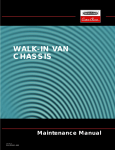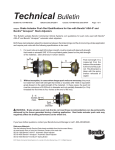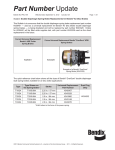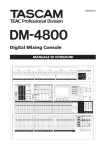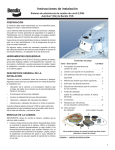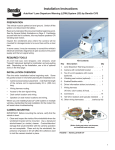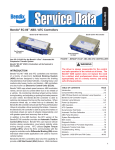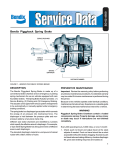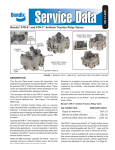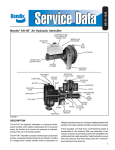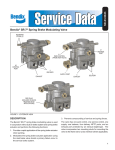Download BENDIX BW7506 User's Manual
Transcript
SD-02-4525 ® Bendix® EverSure® Spring Brake with No Touch™ Technology NON-PRESSURE HOUSING SERVICE RETURN SPRING CLAMP BAND T-BOLT STORAGE POCKET SERVICE DIAPHRAGM NON-SERVICEABLE SECTION SEALED WITH A CRIMPED BAND NON-SERVICEABLE PARKING DIAPHRAGM SERVICE PUSH-ROD RELEASE TOOL T-BOLT YOKE (Piggyback spring brake components are not serviceable, and are shown here for informational purposes only.) RELEASE TOOL DUST T CAP INSTALLED DUST CAP REMOVED SERVICE CHAMBER NON-SERVICEABLE NO TOUCH™ POWER SPRING PARKING/ EMERGENCY BRAKE HOUSING FIGURE 1 - BENDIX® EVERSURE® SPRING BRAKE WARNING SPRING BRAKE CHAMBERS CONTAIN A LOADED COMPRESSION SPRING. PROPERTY DAMAGE, SERIOUS INJURY OR DEATH MAY OCCUR IF THESE INSTRUCTIONS ARE NOT FOLLOWED COMPLETELY. NEVER attempt to remove a spring chamber crimped band. Follow all industry safe maintenance practices, including those listed on page two of these instructions. 1.0 DESCRIPTION The Bendix® EverSure® spring brake is made up of a conventional brake chamber and an emergency, or parking, spring mechanism for use on vehicles equipped with cam foundation brakes. The spring brake actuator provides: (1) service braking, (2) parking and (3) emergency braking. The actuator can be piped with various system arrangements to be automatically, or manually, applied under emergency braking conditions. The spring brake is a diaphragm-type actuator which converts the energy of air pressure into mechanical force. Index Section Page 1.0 Description . . . . . . . . . . . . . . . . .1, 3 2.0 Safe Maintenance Practices . . . . . . . . . 2 3.0 Preventive Maintenance . . . . . . . . . . . 3 4.0 Operation and Leakage Tests. . . . . . . . . 4 5.0 Operation: General . . . . . . . . . . . . . . 4 6.0 Mechanical Release (Caging) of the Bendix® EverSure® Spring Brake . . . . . . . 4 7.0 Clocking (Rotating) the Bendix Service Replacement Spring Brake Chamber. . . . . 5 8.0 Mechanical Release (Caging) and Removal of the Piggyback Spring Brake Chamber to be Replaced . . . . . . . . . . . . . . . . . 6 9.0 Installing the Bendix® EverSure® Piggyback Spring Brake Chamber . . . . . . . . . . . . 6 10.0 Un-Caging the Bendix® EverSure® Spring Brake Chamber (Apply Park Brake) . . . . . 7 11.0 Removal and Installation of the Combination Spring Brake . . . . . . . . . . . . . . . . . 7 12.0 Replacing the Service Diaphragm . . . . . . 8 1 2.0 SAFE MAINTENANCE PRACTICES WARNING! PLEASE READ AND FOLLOW THESE INSTRUCTIONS TO AVOID PERSONAL INJURY OR DEATH: When working on or around a vehicle, the following general precautions should be observed at all times: 1. Park the vehicle on a level surface, apply the parking brakes, and always block the wheels. Always wear safety glasses. Where specifically directed, the parking brakes may have to be released, and/or spring brakes caged, and this will require that the vehicle be prevented from moving by other means for the duration of these tests/procedures. 2. Stop the engine and remove ignition key when working under or around the vehicle. When working in the engine compartment, the engine should be shut off and the ignition key should be removed. Where circumstances require that the engine be in operation, EXTREME CAUTION should be used to prevent personal injury resulting from contact with moving, rotating, leaking, heated or electrically charged components. 3. Do not attempt to install, remove, disassemble or assemble a component until you have read and thoroughly understand the recommended procedures. Use only the proper tools and observe all precautions pertaining to use of those tools. 4. If the work is being performed on the vehicle’s air brake system, or any auxiliary pressurized air systems, make certain to drain the air pressure from all reservoirs before beginning ANY work on the vehicle. If the vehicle is equipped with a Bendix® AD-IS® air dryer system or a dryer reservoir module, be sure to drain the purge reservoir. 5. F o l l o w i n g t h e v e h i c l e m a n u f a c t u r e r ’s recommended procedures, deactivate the electrical system in a manner that safely removes all electrical power from the vehicle. 6. Never exceed manufacturer’s recommended pressures. 7. Never connect or disconnect a hose or line containing pressure; it may whip. Never remove a component or plug unless you are certain all system pressure has been depleted. 8. Use only genuine Bendix® brand replacement parts, components and kits. Replacement hardware, tubing, hose, fittings, etc. must be of equivalent size, type and strength as original equipment and be designed specifically for such applications and systems. 9. Components with stripped threads or damaged parts should be replaced rather than repaired. Do not attempt repairs requiring machining or welding unless specifically stated and approved by the vehicle and component manufacturer. 2 10. Prior to returning the vehicle to service, make certain all components and systems are restored to their proper operating condition. 11. For vehicles with Automatic Traction Control (ATC), the ATC function must be disabled (ATC indicator lamp should be ON) prior to performing any vehicle maintenance where one or more wheels on a drive axle are lifted off the ground and moving. WARNING: Not all wheels and valve stems are compatible with Bendix air disc brakes. Use only wheels and valve stems approved by the vehicle manufacturer to avoid the risk of valve stem shear and other compatibility issues. WARNING: AVOID CREATING DUST. POSSIBLE CANCER AND LUNG DISEASE HAZARD. While Bendix Spicer Foundation Brake LLC (BSFB) does not offer asbestos brake linings, the long-term affects of some non-asbestos fibers have not been determined. Current Occupational Safety & Health Administration (OSHA) regulations cover exposure levels to some components of non-asbestos linings, but not all. The following precautions must be used when handling these materials. • Avoid creating dust. Compressed air or dry brushing must never be used for cleaning brake assemblies or the work area. • Bendix recommends that workers doing brake work must take steps to minimize exposure to airborne brake lining particles. Proper procedures to reduce exposure include working in a well-ventilated area, segregation of areas where brake work is done, use of local filtered ventilation systems or use of enclosed cells with filtered vacuums. Respirators approved by the Mine Safety and Health Administration (MSHA) or National Institute for Occupational Safety and Health (NIOSH) should be worn at all times during brake servicing. • Workers must wash before eating, drinking or smoking; shower after working, and should not wear work clothes home. Work clothes should be vacuumed and laundered separately without shaking. • OSHA regulations regarding testing, disposal of waste and methods of reducing exposure for asbestos are set forth in 29 Code of Federal Regulations §1910.001. These Regulations provide valuable information which can be utilized to reduce exposure to airborne particles. • Material Safety Data Sheets on this product, as required by OSHA, are available from Bendix: Call 1-800-247-2725 and speak to the Tech Team or e-mail us at [email protected] The diaphragm is held between the adapter base and nonpressure plate by a two piece clamp ring. Different size brake chambers are identified by numbers, which specify the effective area of a diaphragm. For example, a Type 30/30 Spring Brake has 30 square inches of effective area on each diaphragm. The standard diaphragm material is a compound of natural rubber with a fabric interior of nylon. WARNING • • • Sp r ing b r a ke cha mb er s c ont ain a load ed compression spring. Property damage, serious injury or death may occur if instructions are not followed completely. When performing any maintenance on the spring brakes, make sure to block the wheels to prevent vehicle rollaway. DO NOT SERVICE A SPRING BRAKE CHAMBER IF IT HAS STRUCTURAL DAMAGE OF ANY KIND. Replace the complete assembly. Dismount a damaged spring brake by first cutting the service push rod with an acetylene torch to relieve any force it might have. • Do not strike any part of a spring brake chamber for any reason. This may cause structural damage. • Be careful not to drop a spring brake chamber at any time. If dropped, inspect for signs of structural damage. Replace complete assembly if damaged. • Spring brake chambers cannot have the emergency diaphragm replaced. Replace the whole spring brake chamber. • Always work from the side of the spring brake chamber. Never work from the front or back. 3.1.2 Check push-rod-to-slack-adjuster alignment from release to full stroke position to be sure the push rod moves out and returns properly without binding at the nonpressure plate hole or with other structures. Also, check the angle formed by the slack adjuster arm and push rod. It should be greater than 90 degrees when the chamber is in the released position and approach 90 degrees at maximum readjustment stroke. 3.1.3 Check tightness of mounting nuts. Torque on the non-pressure plate mounting nuts should be 133-155 ft/ lbs. 3.1.4 Check cotter pins to ensure they are in place. 3.1.5 Check all hoses and lines. They should be secure and in good condition with sufficient length to allow for axle movement. 3.2. EVERY 3,600 OPERATING HOURS, 100,000 MILES OR ONE (1) YEAR: 3.2.1 Carefully inspect all metal parts for cracks, distortion or damage. 3.2.2 Perform the Leakage Test (4.2). As necessary, install a new diaphragm or any other parts if they are worn or deteriorated. All diaphragm sealing surfaces should be smooth and clean. Perform the steps outlined in Section 12 (Replacing the Service Diaphragm). When the service diaphragm, service return spring, or both, are replaced, they should also be replaced in the corresponding chamber on the same axle. PARKING/ EMERGENCY PORT SERVICE PORT 3.0 PREVENTIVE MAINTENANCE RELEASE TOOL SIDE POCKET Important: Review the warranty policy before performing any intrusive maintenance procedures. An extended warranty may be voided if intrusive maintenance is performed during this period. Because no two vehicles operate under identical conditions, maintenance intervals will vary. Experience is a valuable guide in determining the best maintenance interval for a vehicle. 3.1 EVERY 300 OPERATING HOURS, 8,000 MILES, OR ONE (1) MONTH: 3.1.1 See Figure 2. Check push rod travel and adjust travel at the slack adjuster if needed (only where manual slack adjusters are used). Push rod travel should be as short as possible without the brakes dragging (consult the manufacturer’s installation instructions for the slack adjuster. Excessive push rod travel reduces braking efficiency, shortens diaphragm life, gives slow braking response, and wastes air. MOUNTING NUT SERVICE PUSH ROD COTTER PIN YOKE FIGURE 2 - SPRING BRAKE EXTERNAL VIEW 3 MAIN SPRING PARKING/ EMERGENCY PORT (MARKED “12”) DIAPHRAGM DIAPHRAGM NON-PRESSURE HOUSING PUSH ROD FIGURE 3 - SPRING BRAKE CUT-AWAY VIEW 4.0 OPERATION & LEAKAGE TESTS 4.1 OPERATING TEST 4.1.1 Apply the brakes and observe that all the push rods move out promptly and without binding. 4.1.2 Release brakes and observe that all the push rods return to the released position promptly and without binding. 4.1.3 Check the push rod travel. The push rod travel should be as short as possible without the brakes dragging. Adjust travel of push rod at the slack adjuster if necessary. 4.1.4 If the orange stroke indication mark on the push rod is visible, consult the slack adjuster service instructions and verify the proper slack adjuster function. 4.2 LEAKAGE TEST 4.2.1 Make and hold a full brake application. 4.2.2 Using a soap solution, coat the clamping ring(s). If leakage is detected, tighten the clamping ring only enough to stop leakage. DO NOT OVERTIGHTEN as this can distort sealing surface or clamping ring. Coat the area around the push rod hole (loosen boot if applicable). Minimal leakage is permitted (100 SCCM). If abnormal leakage is detected, the diaphragm must be replaced. 4.2.3 Using a soap solution, check the hose fitting for leakage. A one-inch bubble in one minute is acceptable. 5.0 OPERATION: GENERAL The Bendix® EverSure® Spring Brake is made up of the service chamber and the piggyback spring brake chamber. The Bendix EverSure Spring Brake provides service braking, parking, and emergency braking. 4 The spring brake can be mounted with the mounting bolts in either a vertical or horizontal plane on standard mounting stud centers. Two air hoses are used: the service air hose (the connector is marked “11”); and the parking/emergency air hose (the connector is marked “12”). Controlled air pressure enters the service chamber through the inlet port and acts upon the diaphragm, moving the push plate and rod assembly forward. When the service chamber is used to actuate cam-type brake foundation assemblies, the yoke (which is welded to, or threaded on, the push rod) is connected to a slack adjuster, which in turn is connected to the brake cam shaft. This forward motion of the push rod rotates the slack adjuster, cam shaft and cam applying the vehicle brakes. The greater air pressure admitted to the service chamber, the greater the force applied by the push rod. Conversely, the less pressure applied to the service chamber, the less force applied by the push rod. Push rod force is determined by multiplying the delivered air pressure by the effective diaphragm area. For example, if 60 psi is applied to a Type 30 service chamber, the lineal force on the end of the push rod is approximately 1,800 lbs. When air pressure is released from the brake chamber, the push rod return spring – in combination with the brake shoe return spring – returns the diaphragm, push plate and rod assembly, slack adjuster and brake cam to their released positions releasing the brakes. When the driver operates the parking brake, air is exhausted from the chamber. The main spring is allowed to extend, which forces the push rod and the emergency diaphragm forward. This forces the service diaphragm and service push rod forward, which applies the brakes. When the air pressure in the Bendix EverSure Spring Brake chamber drops to below approximately 78 psi, the main spring overcomes chamber pressure and forces the push rod and emergency diaphragm forward. 6.0 MECHANICAL RELEASE (CAGING) OF THE BENDIX® EVERSURE® SPRING BRAKE NOTE: The Bendix ® EverSure® Spring Brake Chamber is not shipped caged. It must be caged prior to any work being done. 6.0.1 This procedure will be made much easier if air pressure (100-120 psi; 6.6-8.0 bar) is used to collapse the power spring by applying air to the port marked “12”, before turning the release bolt nut with a hand wrench or simply by hand. 6.0.2 Remove the dust cap from the keyhole in the center of the spring brake chamber. See Figure 1. 6.0.3 Remove the release tool assembly from the side pocket of the spring brake chamber. 6.0.4 Insert the release tool (T-bolt) through the release tool keyhole and into the power spring piston plate. 6.0.5 Turn the release tool one quarter turn clockwise. SERVICEABLE SECTION SERVICE RETURN SPRING NUT NON-SERVICEABLE PIGGYBACK SECTION PRESSURE PLATE WASHER RELEASE TOOL YOKE YOKE PIN DUST CAP CLAMP BAND SERVICE DIAPHRAGM PARKING/ EMERGENCY BRAKE FIGURE 4 - EXPLODED VIEW SHOWING SERVICEABLE AND NON-SERVICEABLE PORTIONS OF THE BRAKE 6.0.6 Pull on the release tool to ensure the T-section is properly seated in the power spring piston plate. 6.0.7 Assemble the release tool washer and nut onto the release bolt and finger tighten only. If caging is being done manually, it is recommended that some type of lubrication be applied to the release bolt threads prior to tightening to prevent galling or stripping. 6.0.8 To manually cage the spring brake, turn the release tool nut clockwise with a hand wrench. The maximum releasing torque should not exceed 50 lb-ft (67.8 Nm). If the spring has not previously been compressed by the use of air (6.0.1, above), verify that the service side push rod is retracting during the process and that the release bolt is extending from inside the spring brake housing. (DO NOT USE A HIGH SPEED AND/OR POWER DRIVEN IMPACT WRENCH) 6.0.9 Rotate the release bolt nut clockwise until an increased resistance is encountered. This should indicate that proper caging is complete. The release bolt should be extended all the way back, as shown in Figure 4. (DO NOT OVER TORQUE RELEASE BOLT. OVER TORQUING CAN CAUSE SPRING BRAKE DAMAGE.) 6.0.10 Release the air pressure from the emergency/ parking port (port “12”) after caging and prior to any disassembly or removal from the vehicle. IMPORTANT: To ensure the power spring is fully caged, the extended release tool length should be fully backed out as shown in Figure 4. WARNING Do not use an impact wrench. An impact wrench may over torque the release tool and cause damage to the pressure plate. 6.1 SPRING BRAKE CHAMBER REMOVAL 6.1.1 With the spring brake chamber caged and all air pressure drained from the air brake system, disconnect the air hoses from the spring brake chamber. 6.1.2 Remove the cotter pin from the yoke. Remove the yoke pin. 6.1.3 While supporting the spring brake chamber in position, remove and discard brake chamber mounting nuts and washers (see Figure 3). Nuts and washers must not be re-used. Remove the spring brake. 7.0 CLOCKING (ROTATING) THE BENDIX SERVICE REPLACEMENT SPRING BRAKE CHAMBER NOTE: For proper installation, the service replacement spring brake chamber may need to be clocked (rotated) to properly position the ports or clamp band hardware. To do so, follow the clocking procedure. Additionally, the push rod may need to be cut to the proper length for the application. Refer to the Bendix® ASA-5® slack adjuster service data sheet SD-05-1269 or the Bendix® Versajust™ slack adjuster service data sheet SD-05-4630 as applicable, or see guidelines on proper push rod lengths for use with these slack adjusters. 5 WARNING Do not mechanically release (cage) the spring if there is any structural damage to the brake. Caging the spring in such a chamber may cause serious injury or death. Replace the complete spring brake assembly. 7.0.1 If the service replacement spring brake chamber is not caged, mechanically release (cage) the replacement spring brake chamber by following the original manufacturer’s instructions. 7.0.2 Apply 10 psi (1 bar) of air pressure to the service port (“11”) of the spring brake chamber. 7.0.3 Since we will be using locking pliers to hold the service push rod in place, be sure to protect the threads before clamping down. The locking pliers will prevent the push rod from retracting when they are used at the push rod opening of the replacement spring brake chamber. 7.0.4 Release the air pressure from the service port. 8.0 MECHANICAL RELEASE (CAGING) AND REMOVAL OF THE PIGGYBACK SPRING BRAKE CHAMBER TO BE REPLACED NOTE: The spring brake chamber can be replaced with the service brake chamber mounted to the vehicle, or removed, for ease of access. To remove the assembly from the vehicle, perform the steps outlined in Step 11.0 Removal and Installation of the Combination Spring Brake. WARNING Do not mechanically release (cage) the spring if there is any structural damage to the brake. Caging the spring in such a chamber may cause serious injury or death. Replace the complete assembly. 8.1 Mechanically release the old spring brake by following the original manufacturer’s instructions. 7.0.5 Remove the clamp ring and hardware from the spring brake chamber. 8.2 Ensure air pressure is removed from all air reservoirs before removing the air hoses or working on the spring brake. 7.0.6 Position the adapter base inlet port by rotating it with respect to the mounting studs, as needed. 8.3 Remove air hoses from the spring brake chamber. Be sure to mark both hoses to ensure proper reinstallation. 7.0.7 Make sure that the diaphragm is properly aligned and seated. See Figure 5. Be sure that the service diaphragm is fully inserted into the clamp. 8.4 Clamp a pair of locking pliers around the service push rod touching the non-pressure housing. This cages the service return spring. 7.0.8 Reinstall the clamp rings and hardware. Check the arrangement of the removed actuator and position the hardware with respect to the mounting studs as required. Tighten each clamp nut evenly in an alternating pattern. Torque each clamp nut to a final torque of 20-30 ft-lbs. (28-40 Nm). 8.5 Remove the clamp nuts and service clamp assembly and carefully remove the old piggyback chamber. 7.0.9 Inspect the clamp ring and hardware for proper seating. 8.6 Discard the clamp, clamp hardware and diaphragm. 9.0 INSTALLING THE BENDIX® EVERSURE® PIGGYBACK SPRING BRAKE CHAMBER 7.0.10 Apply up to around 10 psi air pressure to the service port of the spring brake chamber. (Do not exceed 10 psi.) Remove the locking pliers from the brake chamber push rod. 7.0.11 Perform the Leakage Test (4.2) before returning the spring brake on the vehicle. INCORRECT CORRECT FIGURE 5 - CORRECT DIAPHRAGM POSITION FIGURE 6 - PIGGYBACK SPRING BRAKE KIT 9.1 Install new service diaphragm. 9.2 Clock chamber (See Section 7.0) as necessary. 9.3 Line up the new spring brake chamber, the service diaphragm, and the non-pressure housing, ensuring that they are centered. 6 9.4 Assemble the service clamp assembly. Ensure all parts are seated properly and remain centered (See Figure 5). 9.5 Torque the clamp nuts to 20-30 ft/lbs. Remove the locking pliers from the service push rod. 9.6 Connect the emergency air hose to the emergency/ parking port (“12”) and reconnect the service air line to the service port (“11”). Torque fittings to no more than 30 ft-lbs (40 Nm). 9.7 Pressurize the service half by putting air into the service port. Do not exceed 120 psig. Perform the Leakage Test (4.2). 10.0 UN-CAGING THE BENDIX® EVERSURE® SPRING BRAKE CHAMBER (APPLY PARK BRAKE) 10.1 Verify that the spring brake has been properly installed on the spring brake bracket and properly attached to the slack adjuster. 10.2 Apply air pressure (100-120 psi; 6.6-8.0 bar) to restrain by air force the power spring. 10.3 Turn the release bolt nut counter clockwise with a hand wrench. (DO NOT USE HIGH SPEED OR POWER DRIVEN IMPACT WRENCH) 10.4 Connect a regulated air line to the emergency/ parking brake port (marked “12”) of the chamber (if not connected previously). 10.5 Continue to turn the release bolt nut until the caging tool is loose. Remove caging bolt nut and washer. 10.6 Push the release bolt tool in, turn the release bolt a quarter-turn counter clockwise and remove it from the pressure plate key hole. 10.7 With hands clear of moving parts, slowly release the air pressure to the emergency/parking brake port (“12”). Be sure to exercise caution to prevent pinching of fingers. 10.8 Place caging bolt in spring brake tool holder with T-head down and seated in slot. Install washer and nut up on exposed threads (this allows the washer to protect the holder cavity and caging bolt from corrosive elements), and torque the caging bolt nut to 10-15 lb-ft (14-20 Nm). 10.9 Mount the dust plug /weather seal in the keyhole located at the rear center of the spring brake chamber. Check around the edge of the dust plug/weather seal to be sure it is firmly seated. IMPORTANT: Always re-install the tethered dust plug/ weather seal in the spring brake caging tool key hole. Failure to do so will result in corrosion and foreign material ingestion through the key hole which may void the warranty. Do not use excessive force when installing the dust plug/ weather seal. Extreme force may cause damage and make it unusable. Replacement dust plugs can be purchased from your local Bendix distributor. WARNING Check for proper service and emergency operation after servicing any part of the brake chamber(s). Check the brake adjustment if the combination spring brake was removed/installed. (Follow the vehicle manufacturer’s instructions to adjust the brakes). 11.0 REMOVAL AND INSTALLATION OF THE COMBINATION SPRING BRAKE 11.1 SERVICE BRAKE CHAMBER REPLACEMENT AND CLOCKING CAUTION: Replace the brake chamber with the same type and size as originally installed on the vehicle. Replacement with alternate equipment (without written authorization from Bendix and the vehicle manufacturer) could compromise brake performance. Brake chambers can be clocked to ensure the proper alignment of mounting studs, drain holes and ports. WARNING! Do not mechanically release (cage) the spring if there is any structural damage to the spring brake chamber. Caging the spring in such a chamber may cause serious injury or death. Replace the complete assembly. 11.2 REPLACING THE COMBINATION SPRING BRAKE 11.2.1 Mechanically release (cage) the old spring brake chamber by following the original manufacturer’s instructions (or use Section 8 for Bendix® brand spring brakes). 11.2.2 Drain system pressure and then disconnect the air hoses from the service brake chamber. Be sure to mark both hoses to ensure proper re-installation. 11.2.3 Remove the cotter and yoke pins, disconnect the yoke from the slack adjuster, remove the mounting nuts, washer, and lock washers and remove the combination spring brake. While removing, use care to prevent the combination spring brake from falling. 11.2.4 Remove the brake chamber mounting hardware from the mounting studs. 11.2.5 Remove the service brake chamber from its mounting bracket. 11.3 CLOCKING (ROTATING) THE REPLACEMENT BRAKE CHAMBER See Section 7 for clocking instructions. INSTALLATION: 11.3.1 Clean and inspect the mounting bracket. Mount the service brake chamber to the mounting bracket. 7 11.3.2 If the service replacement is a type that provides an extra-long threaded push rod, thread a nut onto the rod past the point that it will need to be cut. Taking all necessary safety precautions, cut the rod to the required length and remove burrs. Remove the nut installed earlier to ensure that the threads are clear. 11.3.3 Install the combination spring brake using the furnished hardware. Torque the mounting nuts to 133-155 ft/lbs. (80-210 Nm) Connect the yoke to the slack adjuster and install the yoke pin and the cotter pin. 11.3.4 Connect the air hoses to brake chamber. Torque the fitting to 30 ft-lbs (40 + 5 Nm). Check to be sure the air hoses are properly supported and clamped, if necessary, to provide proper clearance, including checking for proper length when under full steer conditions. 11.3.5 Pressurize the service chamber by putting air into the service port. Do not exceed 120 psig. 11.3.6 Test for leakage (see Section 4.2). Minimal leakage is permitted (100 SCCM). 11.3.7 Uncage the main spring and return the release tool into the release tool side pocket (see Section 10). 11.3.8 Adjust the slack adjuster per manufacturer’s recommendations. 11.3.9 Check the function and stroke (Section 4.1). 11.3.10 Replace the dust cap in the keyhole. WARNING Check for proper service and emergency operation after servicing any part of the brake chamber(s). Check the brake adjustment if the combination spring brake was removed/installed. (Follow the vehicle manufacturer’s instructions to adjust the brakes). 12.0 REPLACING THE SERVICE DIAPHRAGM See Figure 8. To replace the service diaphragm, it is not necessary to remove the complete combination spring brake from the vehicle (however, it can be removed for ease of access). To remove the combination spring brake, perform the steps outlined in Step 11.0 Removal and Installation of the Combination Spring Brake. When either the diaphragm, spring, or both, are replaced, they should be replaced in the corresponding chamber on the same axle. Use only genuine Bendix® brand replacement parts. 8 WARNING A spring brake chamber cannot have the emergency diaphragm replaced. Replace the whole spring brake chamber. 12.0.1 Protect the service push rod with tape, and lock the locking pliers on the push rod close to the non-pressure plate. (This will hold the rod in the applied position). 12.0.2 Ensure that the spring brake chamber is caged. To cage the spring brake chamber, perform the steps outlined in either Step 6.0 Mechanical Release (Caging) of the Bendix ® EverSure® Spring Brake or Step 8.0 Mechanical Release (Caging) and Removal of the Piggyback Spring Brake Chamber to be Replaced. 12.0.3 Mark the service clamp ring and non-pressure plate to ensure proper alignment of par ts during reassembly. 12.0.4 Remove the service clamp ring assembly and the chamber. The service clamp ring is closest to the non-pressure plate and slack adjuster. See provided illustrations if in doubt. 12.0.5 Install new diaphragm. 12.0.6 Line up the spring brake chamber, the service diaphragm, and the non-pressure housing, ensuring that they are centered (see Figure 5). 12.0.7 Re-assemble the service clamp assembly. Ensure all parts are seated properly and remain centered. 12.0.8 Torque the clamp nuts to 20-30 ft/lbs. Remove the locking pliers from the service push rod. 12.0.9 Reconnect the emergency air hose to the emergency port (marked “12”) and reconnect the service air line to the service port (marked “11”). 12.0.10 Pressurize the service half by putting air into the service port. Perform the Leakage Test (Section 4.2). 12.0.11 Per form the Functional Test and Stroke (Section 4.1). 12.0.12 Uncage the main spring and return the release tool into the release tool side pocket (See Section 10). 12.0.13 Replace the dust cap in the keyhole. WARNING Check for proper service and emergency operation after servicing any part of the brake chamber(s). Check the brake adjustment if the combination spring brake was removed/installed. (Follow the vehicle manufacturer’s instructions to adjust the brakes). BW7506 © 2011 Bendix Commercial Vehicle Systems LLC. 08/11. All Rights Reserved. Printed in the United States.








